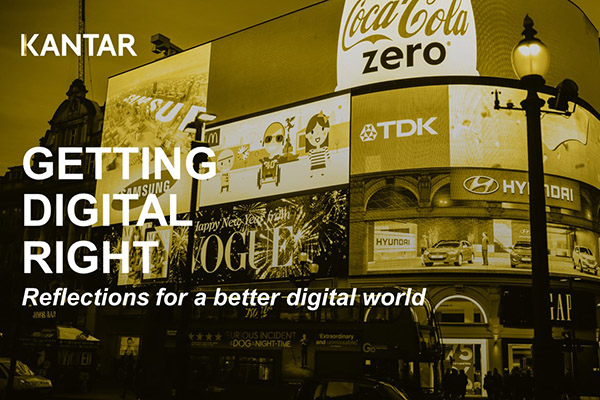Getting digital right: Reflections for a better digital world

Pablo Gomez is the Head of Media & Digital for APAC at Kantar Insights. He sat down with us to talk about the biggest mistakes businesses make in digital marketing (and how to avoid them), his best tips for getting the most out of digital and how to ensure digital has a positive impact on your business.
Where do I start when implementing digital marketing?
Think about how your business and marketing plans can work together. Simplicity is really important and you need to have the right strategy and main objective in place. Plan which media you’re going to use and use it because it’s linked to the strategy, not because you think it might work.
What are the biggest mistakes that businesses make in digital marketing?
I think the first mistake is to call it digital marketing. There shouldn’t be digital marketing, there should just be marketing. Because all marketing should be digital. We still look at things as silos so companies have the media person and the digital person but what you need is one person or one department working for everything. You have specialists, of course but we should all be working together.
The second is that we all have the mindset that digital is cheap and that’s creating a lot of problems. Programmatic, for example is a powerful tool but it shouldn’t be a cheaper tool. We shouldn’t have the mindset that digital is cheap because that’s creating problems around quality and viewability and because we’re not spending a lot and aren’t focussed on digital as an investment.
The third one, and this is linked with the idea of the cheaper option, we’re still not using data enough to actually measure our campaigns. I think advertisers aren’t investing enough in how they measure digital campaigns and so they don’t know what’s working.
What are three ways businesses can get the most out of digital marketing?
I think the three are linked with the previous ones:
Don’t think of digital as a separate thing from the rest of your marketing activity. If we think about it, consumers don’t think that way. We are connected to online and offline channels all the time and we don’t think, “Now I’m in digital, now I’m not in digital”. That’s something we created from a marketing perspective.
A key thing for advertisers is having a marketing plan first. You need to know what your business objective is, what your marketing objective is and what you want to achieve in digital and in your other channels. Your customer strategy should be linked to digital.
Second one, is the use of data. We still have the test and learn mindset but you need to have data to show you what’s working. Sometimes getting the data is not expensive because it’s an investment. If you don’t test your campaigns, you are not learning and if you’re not learning you are wasting your money.
Digital is not the cheaper option, it’s an investment. You need to think about creating a marketing plan around digital instead of just giving it a percentage of your budget.
Think about digital and mobile first and then the rest of the ecosystem. Digital is the future and when we talk about the future, we’re talking about next year and the next couple of years. Digital first is the best approach.
How can business make sure their customers have a good experience with digital marketing?
One of the challenges we have in digital is a relevance challenge. We need to be relevant to consumers. If you don’t have the right message, the impact on your brand is going to be negative. That’s because you’re talking and talking to people who are annoyed and who are not interested in what you’re trying to say. That’s a big problem.
If I’m on mobile and trying to watch video content, I don’t want to see your ad if it’s not really relevant to me.
The six second ad is one solution to engaging people, if it has the right message and the right creativity. If you’re not relevant to me and you have a 30 second ad, all you’re going to do is annoy me.
You need the right creative and to be relevant to your consumers and that’s the big challenge.
How can business reach customers across different marketing channels e.g. Facebook, Neighbourly and print?
25% of the impact of a brand comes from your channels working together so it’s really important. The way to do it is to have a central idea that you want to communicate and based on that, you need to take it into every channel.
The next thing is think about how you’ll talk to people in different places. You need to create content for each channel but it doesn’t have to be more expensive. You could have a two minute video on your website and a 30 second version of it as an ad. Think about how your audience is interacting with each channel. For example, you don’t behave the same on Facebook and YouTube so your content needs to be adapted to that behaviour. It’s really simple if you think about yourself and your own behaviour.
A lot of people don’t like or block ads, what I can do to make mine stand out?
I think the secret is going to be creativity. I’m going to say something that’s really, really obvious and it’s that you need to have good creative in place. People will love it. It can be simple and relevant to your consumers and it’ll work. You need to have the right advertising in place: understand your consumers, have a good strategy and talk to the right people. It’s not easy at the beginning but long term it’s the easiest way.
Pablo Gomez was the APAC Regional Strategy Director at IPG MediaBrands, working for 3 years out of Singapore and another 3 years in Madrid. In Spain he founded The Elevator Team, a creative and digital consultancy created to support IPG Media Brands and McCann World Group agencies. He started his career at Millward Brown Spain, where he implemented the Cross Media and Digital Studies for Coca-Cola across Europe. He is now Head of Media and Digital for Kantar APAC.
This article was originally published by Fairfax Media.

JASON SCHOEMAN
Client Director
[email protected]
Insight and thinking
Read our latest articles and reports, with expert perspective, proprietary data, and thought-provoking insights.